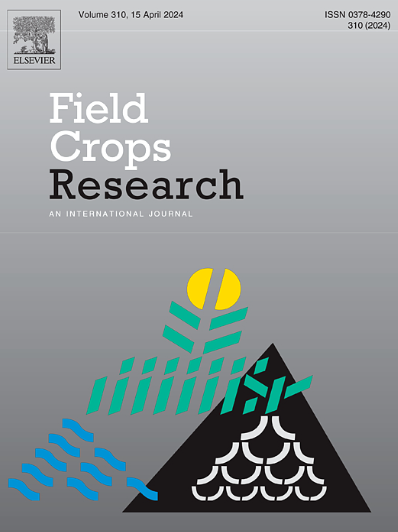滴灌带放置位置和滴灌方式对新疆滴灌棉花根系分布、氮素利用效率和产量的影响
IF 5.6
1区 农林科学
Q1 AGRONOMY
引用次数: 0
摘要
滴灌技术在中国新疆棉田得到了广泛的应用。滴管的位置和滴管的类型直接影响土壤水分和养分的分布,从而影响根系的生长和养分的吸收。然而,滴灌带放置位置和滴灌方式对棉花氮素利用效率和产量的影响尚不清楚。方法采用两种滴管布置方式(宽排(W)或窄排(N))和两种滴管布置方式(单翼迷宫式滴管布置方式(L)和嵌入式滴管布置方式(E)),共4种处理(LW、LN、EW、EN)。结果24 h施肥后,灌水和灌水处理的土壤水分渗透深度大于灌水和灌水处理,灌水和灌水处理在0 ~ 20 cm土层的水分分布更为均匀。LW、LN和EN处理的土壤NO3——N主要集中在窄行,而EW处理的土壤NO3——N主要集中在宽行。LW、LN和EN处理的根长密度(RLD)分布与土壤水分和NO3—N格局一致。与EW和EN处理相比,LW和LN处理使棉花RLD提高了12 % ~ 34 %,根表面积提高了9 % ~ 23 %。与EW和EN处理相比,LW处理显著提高了棉花产量12 % ~ 15 %和37 % ~ 53 %。结论宽排单翼迷宫式滴管滴带可促进棉花根系生长和养分吸收,从而提高氮肥利用效率和产量。本研究有助于优化滴灌配置,提高新疆滴灌条件下棉花产量和氮肥利用率。本文章由计算机程序翻译,如有差异,请以英文原文为准。
Effects of drip tape placement position and dripper type on root distribution, N use efficiency and yield of cotton under drip irrigation in Xinjiang, China
Context
Drip irrigation technology has been widely used in cotton fields in Xinjiang of China. The placement of drip tape and the type of dripper directly influence the distribution of soil moisture and nutrients, thereby affecting root growth and nutrients uptake. However, the effect of drip tape placement position and dripper type on N use efficiency (NUE) and yield of cotton is still unclear.
Method
In this study, two placement positions of drip tape (in wide (W) or narrow (N) rows of cotton plant) and two types of dripper (single-wing labyrinth dripper (L) or embedded dripper (E)) were evaluated, resulting in four treatments (LW, LN, EW, EN).
Results
After 24 h fertigation, EW and EN treatments exhibited deeper soil moisture penetration than LW and LN treatments, while LW and LN showed more uniform moisture distribution in the 0–20 cm soil layer. The soil NO3--N of LW, LN and EN treatments were mainly concentrated in the narrow rows, while that in the EW treatment was concentrated in the wide rows. The root length density (RLD) distribution of LW, LN and EN treatments coincided with soil moisture and NO3--N patterns. Compared with EW and EN treatments, LW and LN treatments increased cotton RLD by 12 %-34 % and root surface area by 9 %-23 %. Compared with EW and EN treatments, the LW treatment significantly increased cotton yield and NUE by 12 %-15 % and 37 %-53 %, respectively.
Conclusion
Therefore, drip tape with single-wing labyrinth dripper placed in wide rows enhances cotton root growth and nutrients uptake, thereby increasing NUE and yield. This research contributes to optimizing drip irrigation configurations and improving cotton yield and NUE under drip irrigation in Xinjiang.
求助全文
通过发布文献求助,成功后即可免费获取论文全文。
去求助
来源期刊

Field Crops Research
农林科学-农艺学
CiteScore
9.60
自引率
12.10%
发文量
307
审稿时长
46 days
期刊介绍:
Field Crops Research is an international journal publishing scientific articles on:
√ experimental and modelling research at field, farm and landscape levels
on temperate and tropical crops and cropping systems,
with a focus on crop ecology and physiology, agronomy, and plant genetics and breeding.
 求助内容:
求助内容: 应助结果提醒方式:
应助结果提醒方式:


